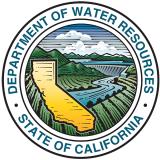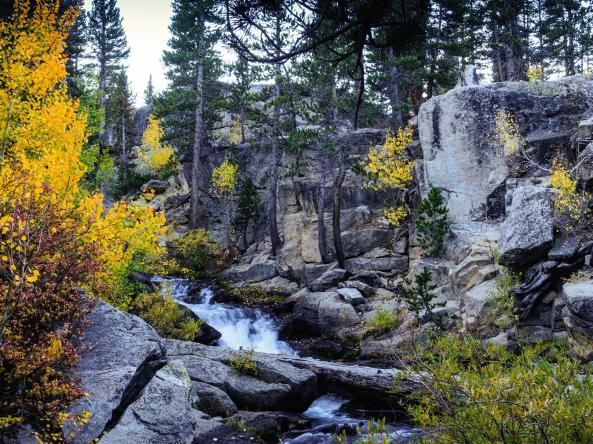April showers bring...little drought relief.
Register here for the June 2 Drought Update and Wildfire Outlook Webinar for California and the Southwest.
Key Points
- April precipitation provided boosts to snow and precipitation totals in northern parts of the region but did not alleviate the drought. 99.9% of California and Nevada is in drought with the expansion of extreme drought (D3) on the U.S. Drought Monitor since the beginning of April.
- Streamflows across California and Nevada and into Lake Powell are forecasted to be below normal, generally 75% of normal or less.
- As the region turns to its dry season, above-normal temperatures—which can impact evaporative demand—are forecasted as well as dry conditions with the exception of areas slightly favoring an enhanced early Monsoon.
- Drought impacts will continue to intensify and expand given a third dry year. Applying lessons learned from past droughts and drought preparedness are key.
The U.S. Drought Monitor (USDM) is updated each Thursday to show the location and intensity of drought across the country. Drought categories show experts’ assessments of conditions related to dryness and drought including observations of how much water is available in streams, lakes, and soils compared to usual for the same time of year.
California/Nevada conditions as of May 10, 2022:
- 99.86% of California is experiencing Moderate (D1) to Exceptional (D4) Drought (59.81% in D3, 0% in D4)
- California population in drought: 37,247,852
- 100% of Nevada is experiencing Moderate (D1) to Exceptional (D4) Drought (46.6% in D3, 8.27% in D4)
- Nevada population in drought: 2,700,551
U.S. Drought Monitor Categories
The U.S. Drought Monitor (USDM) is updated each Thursday to show the location and intensity of drought across the country. Drought categories show experts’ assessments of conditions related to dryness and drought including observations of how much water is available in streams, lakes, and soils compared to usual for the same time of year.
California/Nevada conditions as of May 10, 2022:
- 99.86% of California is experiencing Moderate (D1) to Exceptional (D4) Drought (59.81% in D3, 0% in D4)
- California population in drought: 37,247,852
- 100% of Nevada is experiencing Moderate (D1) to Exceptional (D4) Drought (46.6% in D3, 8.27% in D4)
- Nevada population in drought: 2,700,551
Current Conditions
- April brought widespread precipitation through the northern parts of the region; however, California and Nevada remain in a third year of drought—with recent expansion of extreme drought (D3) across southern and central California and Nevada, according to the U.S. Drought Monitor.
- Most of the region has received between 50%–90% of normal precipitation since the start of the 2022 water year (Oct. 1, 2021). The eastern side of the Sierra Nevada has received above-normal precipitation, while Southeastern California and Southern Nevada have received less than 50% of normal precipitation.
- Although parts of northern California and Nevada received above-normal precipitation in April, the amount of missing precipitation since the beginning of the drought, October 2019, did not show meaningful differences between April 1 and May 1. Much of the region is missing over half a year's to a year’s worth of normal precipitation. Parts of Northern California, Southeastern California, and Southern Nevada are missing more precipitation, between 1–1.5 years’ worth.
- Thus far in the 2022 water year, regional evaporative demand ranks toward the middle of the most recent 40 years. However, much higher evaporative demand has occurred in southern Nevada and southeastern California. This is in contrast to Water Year 2021 when evaporative demand was extremely high throughout much of the region.
- Snow drought improved slightly during April with some cold storms, but continues as many of the stations in California are reporting 0% snow water equivalent (SWE) and Nevada water basins are at or below 75% of normal SWE for this time of year.
- Current water storage in the Western Sierras, represented here as reservoir plus snowpack, is less than half of the normal storage for this time of year. In Nevada, Lake Tahoe, Lake Mead, and Rye Patch are much below average capacity.
- NOAA’s National Weather Service California Nevada River Forecast Center is forecasting below-normal streamflow at most locations.
- Dead fuel moistures status has generally improved since April with much of the region near normal.
- Lake Powell storage has declined continuously since 2019, and is now below 6 million acre-feet. The U.S. Bureau of Reclamation is forecasting unregulated flows into Lake Powell at 62% of normal inflow.
- For more information, check out Living with Drought in Nevada and the California Water Watch.
How is drought affecting your neighborhood? Click to see drought indicators, outlooks, and historical conditions by city, county, and state, as well as sign up for alerts.
U.S. Drought Monitor 1-Month Change Map

Percent of Normal Precipitation: Water Year 2022

April 2022 Precipitation Percentile

Normal Water Years' Worth of Missing or Extra Precipitation

Evaporative Demand Rankings: Water Year 2021 vs. 2022

California Snow Courses: Snow Water Equivalent Percent of April 1 Normal

Nevada Basins: Snow Water Equivalent Percent of Median

Western Sierra Reservoir Storage

Nevada Reservoir Levels

Water Year 2022 Streamflow Volume Forecast

Lake Powell Storage and Inflows


Recent and Potential Drought Impacts
- Find additional impacts through the National Drought Mitigation Center’s Drought Impact Reporter.
- As of May 9, California’s voluntary household dry well reporting system received reports of 76 dry wells in the past 30 days. More information on this and more can be found in the California Drought Update.
- In late April CalFire suspended all burn permits for outdoor residential burning in Monterey and San Benito counties as the fire year has started early.
- In early May the U.S. Bureau of Reclamation—in consultation with the seven states, Mexico, and Native American tribes—informed stakeholders that it would increase releases from Flaming Gorge dam upstream of Lake Powell by 500,000 acre-feet and reduce scheduled 2022 releases from Lake Powell by 480,000 acre-feet
- The Metropolitan Water District released its most restrictive conservation efforts ever on April 27. Water agencies throughout Southern California are determining how to meet and enforce the water restrictions as each region is unique.
- Due to declining lake levels, two sets of human remains have been found in Lake Mead.
- The initial subjective forecast for the 2022 California almond production is 2.80 billion pounds. Forecasted production is 4% below last year's production of 2.92 billion pounds.
- Tule Lake in Northern California is expected to be dry by summer for the first time, which would deprive irrigators of water and leave migratory birds without a rest stop along the Pacific Flyway. Tule Lake is also home to two types of endangered suckers, so the fish are being collected and relocated to nearby ponds.
- The California Public Utilities Commission, the California Energy Commission, and the California Independent System Operator in early May said that California will likely have an energy shortfall equivalent to what it takes to power about 1.3 million homes when use is at its peak during the hot and dry summer months.
- State of California information on water conservation can be found here.
- California and Nevada are no strangers to drought. As the region enters its third year of drought, potential impacts reminiscent of the last multiyear drought are arising. (See the California Department of Water Resources 2012–2016 Drought Overview, Table 1.2 and Chapter 4, and the 2015 Nevada Drought Forum.)
Drought and Climate Outlook
El Niño–Southern Oscillation (ENSO)
NOAA’s ENSO alert system status is currently a La Niña Advisory. Though La Niña is favored to continue, the odds for La Niña decrease into the late Northern Hemisphere summer (58% chance in August–October 2022) before slightly increasing through the Northern Hemisphere fall and early winter 2022 (61% chance). For more information, check out the NOAA ENSO blog.
Subseasonal to Seasonal Drought, Temperature, Precipitation, and Fire Outlooks
The National Weather Service’s Climate Prediction Center is forecasting above-average temperatures for most of the U.S., including California-Nevada, for May through July. For the same time period, precipitation is forecasted to be below normal to equal chances except in those areas impacted by the Monsoon as an enhanced early Monsoon is slightly favored across parts of the Southwest. When extended periods of below-normal precipitation overlap with extended periods of above-normal evaporative demand—which is influenced by above-normal temperatures as well as clear skies, wind speed, and low humidity—fuels can become critically dry, favoring rapidly spreading wildfires. (Read more here from CNAP).
According to the National Interagency Fire Center, fire activity increased markedly in the Southwest and also continued to increase in California, the Great Basin, Eastern Area, and across the plains of the Rocky Mountain Area. The national preparedness level remains at two with the increased fire activity in the Southwest and the forecast increased fire potential in May. As of May 1, most of the Southwest is forecast to have above-normal significant fire potential in May and June, with potential increasing across southern and western Colorado and southern portions of the Great Basin before returning to normal in July. Above-normal significant fire potential is also forecast to increase across northern California from May into July, with rising potential likely along portions of the Sierra Front.
More details can be found here.
Seasonal Drought Outlook: May 1–July 31, 2022

Seasonal (3-Month) Temperature and Precipitation Outlooks


Significant Wildland Fire Potential Outlook: June 2022

Drought Early Warning Resources
Prepared By
Amanda Sheffield
California-Nevada DEWS Regional Drought Information Coordinator, NOAA/NIDIS, CIRES
Julie Kalansky
California Nevada Applications Program (CNAP), Scripps Institution of Oceanography
This drought status update is issued in partnership between the National Oceanic and Atmospheric Administration (NOAA), the California-Nevada Applications Program, a NOAA RISA team, and the Western Regional Climate Center at the Desert Research Institute to communicate the current state of drought conditions in California-Nevada based on recent conditions and the upcoming forecast. NIDIS and its partners will issue future drought status updates as conditions evolve.






